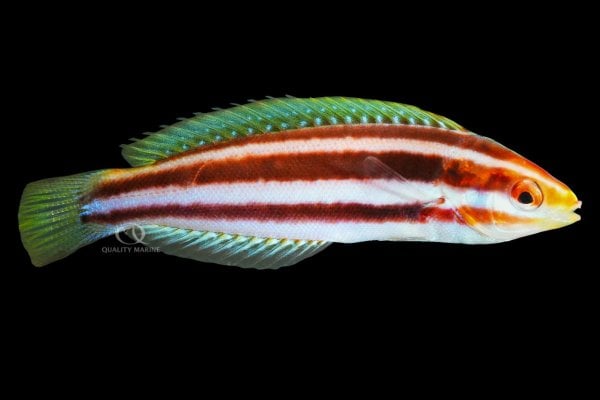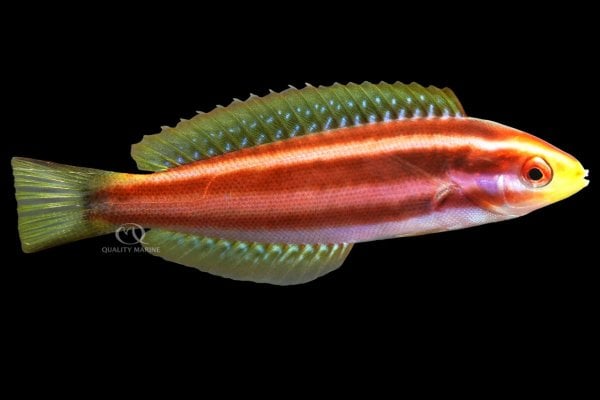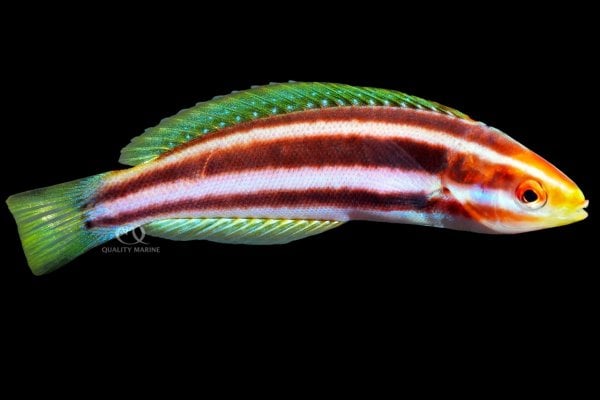The wrasses we all know as Coris are a large and diverse group. A few of them are actually Pseudocoris and get lumped in because of similar body shapes and care requirements. As far as the ones we commonly see in the aquarium hobby, Pseudocoris aurantiofasciata is pretty uncommonly seen, and this is unfortunate. They are gorgeous, hardy, active and intelligent fish that are a joy to watch in a saltwater display. They go by the common moniker “Rust-Banded Wrasse,” and less frequently “Sand Wrasse.”

In the wild, these fish are usually found in small harems (a group where there is one dominant male and multiple females / juvenile fish). Generally, they are collected in relatively shallow water, under 120 feet deep, near reef edges and steep drop offs in the Indo-Pacific Ocean region. The largest male on record is a seven and a half inches long, but a much more common size is five to six inches for males, and four to five for females. Like many wrasses, they undergo a dramatic color change as they mature, with the juveniles bearing their distinctive orange and white stripes with neon yellow fins and nose. As they mature, they'll turn the angry purple blue of the ocean on a stormy day, with males developing several vertical orange/brown stripes along their flank, while the females will have gentler, ombre color fade to teal and orange yellow along their belly. All the color forms of this fish are beautiful, and watching the slow transformation over time is very rewarding.

Feeding these wrasses is usually very easy. They are plankton eaters in the wild and live in spaces where there is an abundance of current. This means their natural feeding behavior is to quickly grab whatever food comes by, and this translates to feeding very effectively in the home aquarium. In house, we feed them a mix of meaty food from Gamma foods. For frozen foods, Gamma is always our choice. They offer a wide range of frozen products which allows us great variation. Their foods are all gamma irradiated, eliminating any chance that food borne pathogens can make their way into our system (or your aquarium.) The mix we use will contain a variety of different products like chopped prawn, chopped mussel, mysis, a variety of enriched brine, and copepods among others. We also feed a high quality, nutrient dense pellet from Nutramar (Nutramar Complete) which most of the fish accept after a few feedings. We feed them twice a day here, and this should be your practice too unless you want to spread that food out over even more feedings. Even fully grown, we suggest maintaining a twice a day schedule. Click here to learn more


In the wild, these fish are usually found in small harems (a group where there is one dominant male and multiple females / juvenile fish). Generally, they are collected in relatively shallow water, under 120 feet deep, near reef edges and steep drop offs in the Indo-Pacific Ocean region. The largest male on record is a seven and a half inches long, but a much more common size is five to six inches for males, and four to five for females. Like many wrasses, they undergo a dramatic color change as they mature, with the juveniles bearing their distinctive orange and white stripes with neon yellow fins and nose. As they mature, they'll turn the angry purple blue of the ocean on a stormy day, with males developing several vertical orange/brown stripes along their flank, while the females will have gentler, ombre color fade to teal and orange yellow along their belly. All the color forms of this fish are beautiful, and watching the slow transformation over time is very rewarding.

Feeding these wrasses is usually very easy. They are plankton eaters in the wild and live in spaces where there is an abundance of current. This means their natural feeding behavior is to quickly grab whatever food comes by, and this translates to feeding very effectively in the home aquarium. In house, we feed them a mix of meaty food from Gamma foods. For frozen foods, Gamma is always our choice. They offer a wide range of frozen products which allows us great variation. Their foods are all gamma irradiated, eliminating any chance that food borne pathogens can make their way into our system (or your aquarium.) The mix we use will contain a variety of different products like chopped prawn, chopped mussel, mysis, a variety of enriched brine, and copepods among others. We also feed a high quality, nutrient dense pellet from Nutramar (Nutramar Complete) which most of the fish accept after a few feedings. We feed them twice a day here, and this should be your practice too unless you want to spread that food out over even more feedings. Even fully grown, we suggest maintaining a twice a day schedule. Click here to learn more












